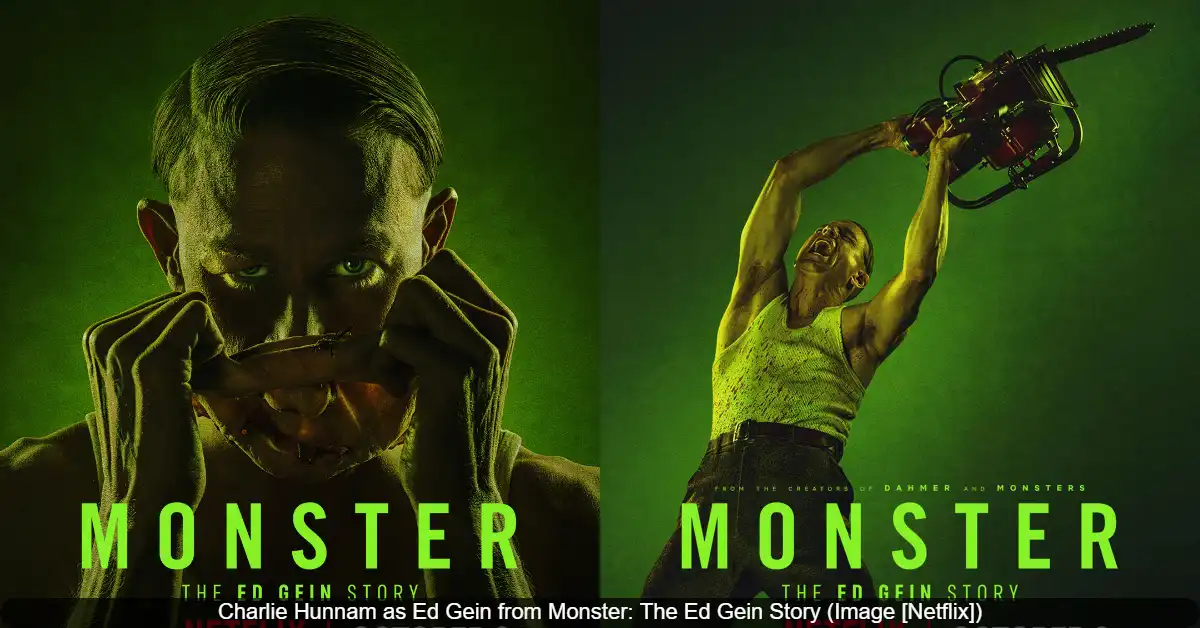The latest season of Ryan Murphy’s Monster anthology, Monster: The Ed Gein Story, has landed on Netflix and is already stirring significant conversation. While critics are deeply divided on the show’s quality and approach, the series has quickly become a major streaming draw for Netflix, following the successful pattern of its predecessors, Dahmer and The Menendez Brothers Story.
The series tells the shocking true-life tale of Ed Gein, the infamous murderer and grave robber from Wisconsin whose crimes inspired some of Hollywood’s most iconic on-screen killers, including Norman Bates from Psycho and Leatherface from The Texas Chain Saw Massacre. Starring Charlie Hunnam as the titular killer, the show explores the twisted events that turned a reclusive farmhand into the blueprint for modern horror.
The Story of a “Monster”
Monster: The Ed Gein Story is a drama series consisting of eight episodes, all released on October 3, 2025. The season is created by Ian Brennan and is the third installment in the Monster anthology. The story begins on a remote Wisconsin farm, where troubled loner Ed Gein’s twisted bond with his domineering mother, Augusta, triggers a terrifying descent into madness.
The series aims to be more than just a crime recap. It positions Gein as one of the most influential figures of the 20th century, whose personal horrors fundamentally changed the horror genre. As co-creator Ryan Murphy explained, the core question of every season is: “Are monsters born or are they made? And I think in Ed’s case, it’s probably a little of both.”
The narrative doesn’t just focus on Gein’s crimes in the 1950s. It also weaves in the stories of the Hollywood filmmakers he later inspired, including Alfred Hitchcock and the making of Psycho, Tobe Hooper and The Texas Chain Saw Massacre, and even the creation of Buffalo Bill in The Silence of the Lambs.
A Controversial Critical Reception
Despite its popularity with viewers, the show has received a mixed and often harsh response from television critics, highlighting a clear divide between audience interest and critical approval.
One major criticism is the show’s perceived hypocrisy. Several reviews point out that the series graphically depicts Gein’s violent and sexual crimes while simultaneously scolding the audience for being interested in such content. One review called the series “a thematically ambitious mess” that eagerly provides nauseating scene after nauseating scene in order to continue the vile tradition it claims to be damning.
The narrative structure has also been called into question. Critics found the show “wildly unfocused” and “thoroughly disjointed,” with a storyline that jumps around in time and incorporates subplots about Hollywood that feel underdeveloped. The show has been accused of taking major liberties with historical facts, particularly in its portrayal of a character named Adeline Watkins, a local woman whose real-life connection to Gein remains unclear.
However, the performances have been widely praised. Charlie Hunnam is noted for his “terrifyingly committed” transformation into Ed Gein, for which he lost over 30 pounds and adopted a soft, high-pitched voice. The cast also features powerful performances from Laurie Metcalf as Gein’s abusive mother, Augusta, and Tom Hollander as Alfred Hitchcock.
Understanding the Real Ed Gein
So, who was the real man behind this controversial show? Ed Gein, known as the “Butcher of Plainfield,” was a serial killer and grave robber who haunted rural Wisconsin in the 1950s. He is confirmed to have killed two women: tavern owner Mary Hogan and hardware store owner Bernice Worden.
Upon his arrest in 1957, authorities discovered a house of horrors on his farm. The findings were so gruesome they have become the stuff of legend: furniture and household items made from human bones and skin, skulls used as soup bowls, and the component parts of a “woman suit” made from stitched-together human skin, which he used to pretend to be his mother.
His story, while involving a relatively low number of confirmed murders, became culturally significant because of the sheer grotesquery of his actions. As one criminology professor explained, “There are a lot of other cases that are bizarre in one dimension or another, but this had the whole smorgasbord.” Gein was ultimately found not guilty by reason of insanity and spent the rest of his life in psychiatric hospitals until his death in 1984.
A Streaming Success Story
The critical debate seems to have done little to slow down the show’s momentum. While an official Rotten Tomatoes score was not immediately available upon release—suggesting critics were not given early screeners—the series has performed strongly on Netflix’s platform.
This follows the proven success pattern of the Monster franchise. The first season, Dahmer, became one of Netflix’s most-watched series ever, garnering 115.6 million views and beating out massive hits like Bridgerton. The attraction to such dark, true-crime stories remains powerful. As one expert noted, “We were telling stories of crime and murder as soon as we could produce print media. The desire to try to explain and distance oneself from it is a very understandable desire.”
For his part, star Charlie Hunnam hopes the series offers a deeper look at the man behind the monster. He stated, the project was a “really human, tender, unflinching, no-holds-barred exploration of who Ed was and what he did. But who he was being at the center of it, rather than what he did.”
Also Read: Monster: The Ed Gein Story – Did Ed Gein Kill Adeline Watkins?











